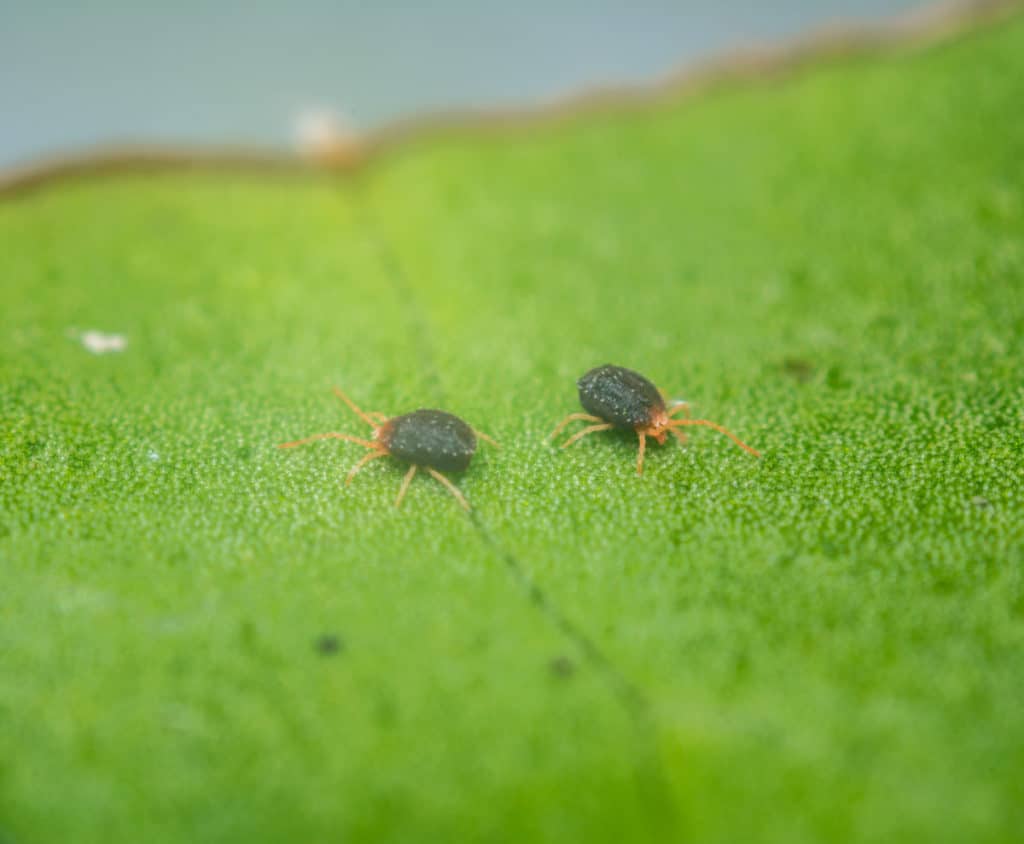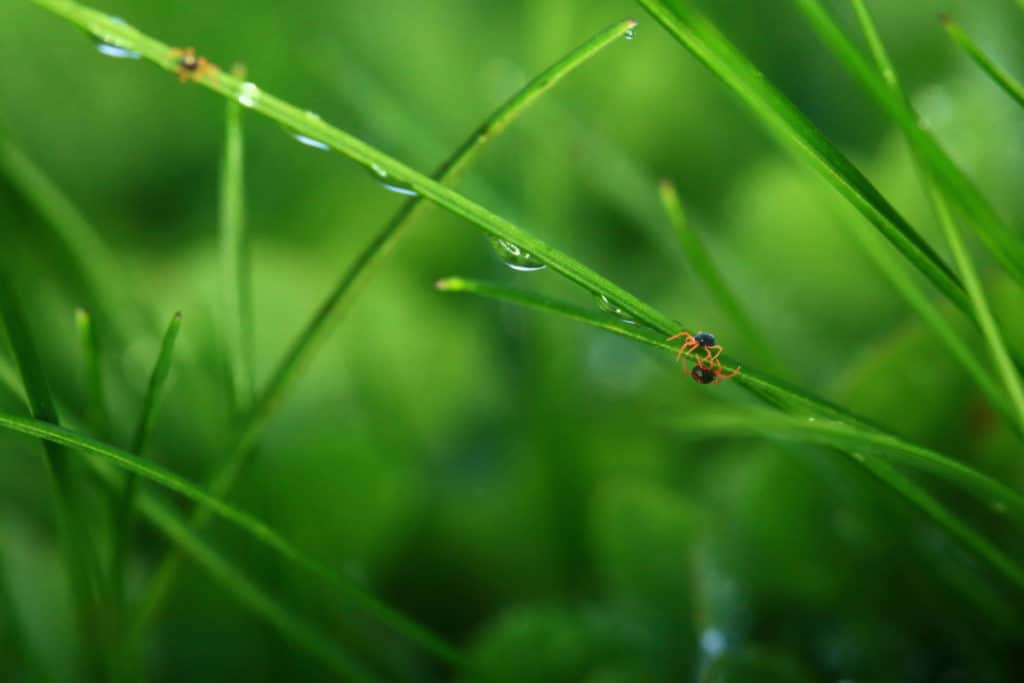Clover mites are often seen in the grass next to the foundation of buildings. They feed on grass, weeds, and clover, so if you want your lawn to stay fresh and green you might want to get rid of these pesky creatures. However, their small size makes this task super challenging.
When active, the lifespan of clover mites is only about two weeks. Clover Mites are also parthenogenetic, meaning baby clover mites can come out of unfertilized eggs. As a result, their population is composed entirely of females.
But, Do clover mites die in winter? As a general rule, adult clover mites do not die in winter if they can find shelter in structures or crack and crevices that provide protection from the cold. Their eggs will also survive the winter hatching when temperatures are above 24°C (75°F). Clover mites are active in Spring and Fall.
The rest of this article will explain in detail when clover mites are most active, their life cycle, whether they are harmful, and the different ways to get rid of these pests.
Life Cycle Of Clover Mites
Although the lifespan of clover mites is just two weeks, there are a series of events that happen within this short period. As the clover mite community is composed entirely of females due to their parthenogenetic nature, each mite can lay about 70 eggs at a time.

The eggs are typically small, round, and red, usually laid in dry areas like the base of trees or cracks in the building. The eggs are given special protection to survive in extreme heat and freezing winters.
The adult mites are just 1/30 inch long, smaller than the head of a pin, so you can imagine how small the little mites would be. During summer, the eggs stay dormant, and this is when the adults die.
The eggs generally hatch in October, especially when the temperature drops below 24°C (75°F). But if the soil temperature is very low, the hatching may be delayed to late winter.
What Season Are Clover Mites Most Active?
Research suggests that clover mites are most active in spring and fall. This is because they prefer cooler weather and cannot withstand extreme temperatures like summer and winter. Therefore, expect active clover mites running around in your home in spring and fall.

The eggs usually remain dormant during these two seasons and most of the adults die during summer.
What Temperature Kills Clover Mites?
Clover mites will die if exposed to temperatures above 39°C (102°F). In summer, the eggs will remain in dormancy while the adults die. This is because these pests cannot withstand extreme temperatures.
The eggs also become inactive when the temperature drops below 24°C (75°F). Generally, clover mites prefer cooler seasons and are most active during spring and fall. The eggs usually hatch in October.
What Time Of Year Would Clover Mites Get Into My House?
Clover mites are most active during the cooler seasons, namely spring and fall. This time of the year is also when the eggs hatch and baby clover mites come out.
Expect these home-invading pests during early spring and take precautionary measures to prevent the mites from entering your home.
Why Do I Have Clover Mites In My Home?
If you have a large number of clover mites in your home and garden, the reason may be one or more of these:
- Cracks and crevices in your home
- Over-fertilized lawn
- Grasses and weeds growing near the foundation of the house
- Presence of mulch near the house
Are Clover Mites Harmful?
Clover mites do not do any physical harm. They don’t bite or transmit diseases like ticks. However, you would not want clover mites hanging around your living room. Here’s why:
- As clover mites are smaller than the head of a pin, they can enter your home through the tiniest cracks and crevices. Walls, curtains, carpets, and fabrics are some of the most common spaces clover mites occupy.
- Our sudden instinct when we see mites is to probably crush them. But crushing clover mites can leave an orange stain on your fabrics and furniture due to their pigmented bodily fluids.
- Another reason why clover mites are considered a nuisance is that they can damage your neatly maintained lawn. Patches of dry grass and brown coloration of leaves are the most common adverse effect of having clover mites in your garden.
But unlike most arthropods, these householding invading pests do not pose any threat to human health.
Keep an eye out for chiggers though, these guys can be nasty and are often mistaken for clover mites. Check out this article we have written to make sure you can spot the difference, Clover Mites Vs Chiggers: Are They The Same Thing?
How Do You Get Rid Of Clover Mites?
Since they are so small that you can’t even spot them, getting rid of them is not easy. But this does not mean these pests will forever be in your home.
You can always try different methods to make your home inaccessible to these tiny little arthropods. Here are a few actionable steps you can take to get rid of clover mites from inside and outside your home:
Outside The Home
Remove Weeds And Grasses
As clover mites feed on grassy lawns and weeds, make sure you cut out the grasses and weeds surrounding your home. If you have a garden, look out for clover mites there also as these are attracted to fertilized lawns.
If you are interested in a detailed look at what clover mites feed on then check out this article we have written, What Do Clover Mites Eat?
Seal Up Cracks And Crevices
Keep in mind that you’re dealing with tiny pests! Clover mites don’t fly. So make sure that you seal every crack and crevice to prevent clover mites from entering your home.
Caulks are effective in covering up small cracks in all the nooks and corners. You can also use wood glue or wood putty.
Plant Flowers That Clover Mites Don’t Like
If you didn’t know already, clover mites are not the fan of all flowers. For instance, they are not attracted to flowers like petunia, chrysanthemum, rose, salvia, etc. Plant these around your house to encourage the mites to find a new home.
When looking for clover mites in your garden keep an eye out for spider mites they are often mistaken for clover mites. If you are interested, check out this article we have written so you know how to tell them apart, Clover Mites Vs Spider Mites: What is the Difference?
Chemical Treatment
Another way to get rid of clover mites is to spray a miticide on your lawn. If you’re using the insecticide indoors, make sure it’s indoor-safe, especially if there are children or pets.
Do Not Over Fertilize
Clover mites are attracted to heavily fertilized lawns and mulch. Check whether you’re applying more than the required amount of fertilizer in your garden.
Crushed rock or gravel around the house can also make it difficult for the mites to travel indoors from the backyard.
Inside the home
Use A Vacuum Cleaner.
It is important to keep your home clean to get rid of clover mites because, well, all bugs love dirty places. Take the vacuum cleaner and dust off all the nooks and corners.
Clean the vacuum cleaner collector bag after you’ve dusted the entire house. Dispose of the bag safely so that the bugs won’t come out and find their way back home.
Avoid Crushing The Mites.
When you encounter these tiny little pests, refrain from crushing them. This is because their pigmented bodily fluid can flow out that will leave a red stain on your furniture or fabric. Therefore, it is always advised to remove them using a vacuum cleaner.
Refrain From Using Pesticides Indoors.
It is better not to use chemical insecticides indoors as it can be unsafe for pets and children. If using one is necessary, make sure to choose an indoor-safe miticide.
Stick Double-sided Sticky Tape.
Double-sided tape can catch the mites as they cross the tape. Place these sticky tapes on window sills and underneath the doors to tap the clover mites. Once they get stuck to it, simply peel it up and dispose of it.
Before you take the precautionary measures, examine whether the bug in your house is a clover mite. This can be done by observing their legs. Clover mites have eight legs, with the front legs unusually longer than the others.
After you make sure that it is a clover mite, try the above methods both outdoors and indoors.
If none of the above seem to work, seek the help of a professional pest control company.
The Wrap Up
Clover mites don’t die in winter unless it is cold. They usually die in summer in the heat. The eggs remain dormant during extreme seasons, like summer and winter. These mites are most active during spring and fall.
So take precautionary measures at this time of the year to prevent these pests from entering your home. Although they are not dangerous to humans, the red pigment they leave behind when crushed can stain your furniture and fabrics. Moreover, clover mites feed on grass and clover and are mostly attracted to over-fertilized lawns.
If you are interested in how other bugs cope with the winter months then take a look at these other articles we have written:
What Happens To Wasps In Winter? (See Who The Survivors Are)
How Do Bees Survive The Winter?
How Long Do Spiders Live? One Species Can Live For Decades
Sources
https://arborscapeservices.com/winter-mite-control/
https://agrilifetoday.tamu.edu/1997/03/04/winter-or-not-clover-mites-might-be-a-problem-around-home
https://www.americanpest.net/blog/post/what-to-do-if-clover-mites-invade-your-home-this-winter
https://lancaster.unl.edu/pest/resources/clovermites312.shtml
https://www.pestworld.org/news-hub/pest-articles/clover-mites-flourish-in-early-spring/
http://entnemdept.ufl.edu/creatures/orn/mites/clover_mite.htm
https://www.youtube.com/watch?v=jSsF7usyHCg
https://bepestfree.com/keeping-pests-four-steps-seal-cracks-crevices-home/
